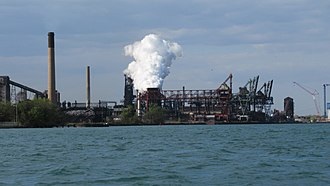
Zug Island. Wikipedia photo.
Starting in about 2011, residents of Windsor, Ontario, Canada, reporting hearing what came to be called the “Windsor Hum.” The mysterious and annoying sound comes and goes, but it is a low-pitched sound of about 30-35 Hz with an apparent range of several miles. It’s often described as being similar to a truck idling nearby.
Long suspected as the source of the sound is Zug Island, an artificial island in the Detroit River, on the U.S. side of the international border.

Samuel Zug. Carlisle, PA, Sentinel 8 Dec. 1905 .
Named after an early owner, Samuel Zug, the island was formed from a natural peninsula where he originally intended to build a luxurious estate. The swampy character of the land led him to abandon the idea, and he instead used it for industrial purposes. In 1888, he allowed a small canal to be cut, turning the peninsula into an island, and this canal was enlarged by Henry Ford in the 1920s for easier river access to the River Rouge Ford plant.
The island became a site of iron making as early as 1901, and the entire island is currently part of United States Steel Corporation’s Great Lakes Works. The portion of the plant on the island produces iron, which is processed into steel at facilities in Ecorse, MI, a couple of miles south. The island facility includes three blast vessels, which are believed by many to be the source of the sound.
The Ontario Ministry of Natural Resources concluded in 2011 that Zug Island was the source of the mystery sound. A 2014 report by researchers at the University of Windsor also concluded that the blast furnace operations on Zug Island were the likely source. However, because the intermittent sound was not present on days when some of the research equipment was deployed, the report found that “conclusive evidence of the source was not achieved.”
Interestingly, Zug Island also bears the distinction of being the scheduled destination of the SS Edmund Fitzgerald on her last voyage in 1975. Contrary to the artistic license taken by the song, she wasn’t “fully loaded for Cleveland.”
According to one published report (QST for May 2019), Zug Island is “governed by Homeland Security,” although I’ve found no evidence of this. As with any industrial plant, access is not granted to non-employees to come in and take a look around. Therefore, it’s understandable that the two bridges to the plant are “heavily guarded” as the article claims. The “governed by Homeland Security” claim probably arises from the fact that some of the “No Trespassing” signs posted by U.S. Steel, in an apparent attempt to add emphasis, include language that “under Homeland Security, any individual within 100′ of a docked ship must possess a TWIC card.” Since ships obviously dock on the island to load and unload cargo, this Homeland Security regulation comes into play, as it would at any maritime facility.
The existence of the hum has given rise to a certain amount of citizen science to collaborate in the identification and elimination of the hum. Much of this is carried out in a Facebook group created in response to official inaction.
If you want to hear the hum yourself, it is available at the following video, posted by the Facebook group’s founder . To listen, however, you will need a speaker system or headphones with very good bass response, in order to reproduce the 30-35 Hz. With typical computer speakers or headphones, you will not be able to hear the sound.
Conspiracy buffs might be disappointed, but while the source of the hum has not been pinned down with absolute precision, the likely source has been identified.
Additional References
- “What’s Going on With Detroit’s Mysterious Zug Island?” at HowStuffWorks.com.
- “The ‘Windsor Hum’: where is the noise plaguing a city of 210,000 coming from?” at The Guardian.
- “A Mysterious Hum is Plaguing Windsor, Canada” at vice.com.
- “A Mysterious Hum Has Been Haunting the Town of Windsor for Years” at ReadersDigest.ca.
Author’s Note: This post is obviously a bit off-topic, since we normally discuss radio history at this blog. (However, we’re prone to branch off into seemingly unrelated topics, so this isn’t the first time we’ve done so.)
The reason why I posted this article is because QST, the membership journal of the American Radio Relay League, published in its May 2019 issue a similar article. I had a number of criticisms of the article, to the point where I thought that I could do a better job myself. So rather than simply criticize, I decided to go ahead and write my own article. The original QST article is probably more polished, as the result of better editing. But even though I wrote it in a day based upon online research, I think mine is better. Here are my concerns with the QST article:
First and foremost, every issue of QST carries on its masthead the words “devoted entirely to amateur radio.” This article, while perhaps interesting, really has nothing whatsoever to do with Amateur Radio. Notably, the author is not a ham, and probably not an ARRL member. Yet three valuable pages of the membership journal were devoted to this off-topic information (and one of those pages consisted of a stock photo). While the article might have covered a topic that was interesting to some members (including myself), it seems like a poor use of such valuable real estate. After all, most members are paying almost $50 per year for membership, and a good portion of that amount is earmarked for the magazine. It might have been a good choice to go on the ARRL website, but putting it in print seems to me to be poor use of membership resources. The editors appear to have noticed this, as they did interview a local ham, who reported that the hum hadn’t affected his radio operations, and that he didn’t know of any other hams who were affected in any way.
More importantly, Amateur Radio is a technical hobby, and if members are interested in this topic, then it stands to reason that they are probably interested in the technological aspects. On this point, the article really lets them down. It uses vaguely “conspiracy theory” oriented language rather than any technical facts. A few trappings of science are included. For example, it includes a graph purporting to show the sound wave. But no explanation is given of the waveform, much less any explanation of how the graph was produced. It’s undoubtedly an oscillograph of a waveform picked up by microphone, but the article doesn’t explain where, when, or how. In fact, the illustration inexplicably shows two copies of the same graph, one on top of the other. Significantly, the article lacked any footnotes or references where the reader might learn more.
And as noted in my article, the article makes the claim that the island is “governed by Homeland Security.” Then, in conspiracy-theory tradition, it goes on to pose questions as to why Homeland Security would be involved, but doesn’t answer those questions.
Also, my first reading of the article left me confused as to whether Zug Island was located in the United States or in Canada. When I started reading, I assumed that the article was talking about a Canadian island. After reading to the end, I correctly guessed that the island was actually on the U.S. side of the border. But I didn’t know for sure until I did independent research.
Other than being written by the producer of a “popular podcast,” I have no idea why this article appeared in QST. I don’t mind the occasional foray into off-topic material. In fact, I enjoy the “Eclectic Technology” column which usually covers non-radio technology that is still of interest to hams. The reason why that column works is because the author knows that readers will be interested in scientific and technical topics.
An article about the Windsor Hum would be at home in a magazine with a broad audience such as Popular Science. But even the editors of such a general-interest magazine would pay more attention to accurately reporting facts, rather than merely hinting at conspiracy theories. And QST readers certainly deserve better.
DE W0IS.

